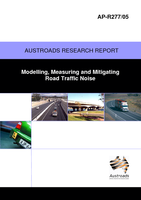Environment

Modelling, Measuring and Mitigating Road Traffic Noise
- Publication no: AP-R277-05
- ISBN: 1 921139 08 0
- Published: 1 November 2005
- PDF (free) Download
This Report examines the role of noise impact assessment in the management of road traffic noise. Part 1 provides an overview of noise impact assessment including issues such as the existing noise environment, route selection and route changes, traffic volumes and compositions, noise criteria, noise modelling, prediction of noise levels, impact assessment, noise control requirements and recommendations. Part 2 examines noise modelling and discusses a range of related issues including commonly used noise models, traffic noise calculation methods, noise modelling software packages including acceptable noise models for use within Australia, quality control issues relating to noise modelling and the use of conversion factors. Part 3 examines noise measurement and monitoring and discusses a range of related issues including the specific quantities to be measured, measurement accuracy, measurement location, measurement duration, selection of sites and selection of valid days. Part 4 provides an overview of noise mitigation approaches and discusses three key noise mitigation principles: noise control at the noise source; noise reduction between the source and receiver, and noise reduction at the receiver.
- AP-R277/05 Modelling, Measuring and Mitigating Road Traffic Noise
- EXECUTIVE SUMMARY
- CONTENTS
- TABLES
- FIGURES
- 1. INTRODUCTION TO ROAD TRAFFIC NOISE
- 1.1. Managing road traffic noise
- 1.2. About noise
- 1.2.1. Environmental noise indices
- 1.2.2. Traffic noise descriptors
- 1.2.3. Conversion between different descriptors
- 2. INTRODUCTION TO NOISE IMPACT ASSESSMENT
- 3. NOISE IMPACT ASSESSMENT STRUCTURE
- 3.1. Background information of study area and project purpose
- 3.2. Route selection and route changes
- 3.3. Existing noise environment
- 3.4. Traffic volumes and compositions
- 3.5. Noise criteria
- 3.6. Noise modelling
- 3.7. Prediction of noise levels and impact assessment
- 3.8. Noise control requirements
- 3.9. Conclusions and recommendations
- 4. OVERVIEW OF NOISE MODELLING
- 5. MODELS, METHODS, SOFTWARE
- 6. TRAFFIC NOISE CALCULATION METHODS IN USE
- 7. NOISE MODELLING AND QUALITY CONTROL
- 8. COMMONLY USED NOISE MODELS
- 8.1. Calculation methods
- 8.2. Software packages
- 8.3. Use of conversion factors
- 9. OVERVIEW OF NOISE MEASUREMENT
- 10. MEASURING NOISE
- 11. REASONS FOR MEASURING NOISE
- 12. MEASUREMENT ACCURACY
- 12.1. Data reliability
- 12.2. Measurement duration
- 12.3. Measurement location
- 12.4. Selection of valid days
- 12.4.1. Weather conditions
- 13. SITE SELECTION
- 13.1. Prior to construction
- 13.1.1. Snapshot or before/after study
- 13.1.2. Criteria dependent on pre-construction noise levels
- 13.1.3. Pre-construction noise measuring
- 13.2. Ongoing monitoring
- 13.2.1. Ongoing review of compliance
- 13.2.2. Ongoing review of community exposure
- 13.3. After construction
- 13.3.1. Determination of compliance with criteria/goals
- 13.3.2. Selecting sites
- 13.3.3. Post completion measuring
- 13.3.4. Response when non-compliance is indicated
- 13.3.5. Assessing compliance when noise limits are flexible
- 13.3.6. Post construction noise assessment report
- 14. MANUAL NOISE MEASUREMENTS
- 15. NOISE MITIGATION OVERVIEW
- 15.1. Mix of noise mitigation measures
- 15.2. Noise management in all phases
- 15.3. Noise mitigation effectiveness
- 15.3.1. Perceptions of change in noise exposure
- 15.3.2. Practical considerations
- 15.3.3. Noise reduction potential
- 16. NOISE CONTROL AT THE SOURCE
- 16.1. Quieter vehicle design
- 16.2. Quieter vehicles while in-service
- 16.2.1. Tyre/road noise
- 16.2.2. Pavement surface type and design
- 16.3. Driver behaviour
- 16.3.1. Reducing traffic speed
- 16.3.2. Traffic calming devices and smooth traffic flow
- 16.3.3. Quiet driving sign posts and heavy vehicle restrictions
- 16.4. Road design
- 16.4.1. Road alignment
- 16.4.2. Intersections
- 17. NOISE REDUCTION BETWEEN SOURCE AND RECEIVER
- 17.1. Cuttings and embankments
- 17.2. Tunnels and enclosures
- 17.3. Noise barriers
- 17.3.1. Noise reduction capability
- 17.3.2. Construction
- 17.3.3. Parallel barriers
- 17.3.4. Diffraction edge treatments
- 17.3.5. Limitations
- 17.3.6. Public reaction
- 17.3.7. Earth mounds
- 17.3.8. Vegetation
- 18. NOISE REDUCTION AT THE RECEIVER
- 18.1. Site planning
- 18.1.1. Increasing setback distance
- 18.1.2. Use of built form to provide noise shielding
- 18.1.3. Use of natural features such as slopes
- 18.1.4. Provision of noise mounds or walls within the site
- 18.2. Acoustic treatment to buildings
- 18.2.1. Road traffic noise intrusion
- 18.2.2. Treatment for existing buildings
- 18.2.3. Design, siting and layout of new buildings
- 18.2.4. Construction of new buildings
- REFERENCES
- APPENDIX A. TERMINOLOGY
- A1 About noise
- A2 Glossary of acoustic terms
- A3 Use of traffic noise descriptors
- A4 Relevant standards
- APPENDIX B. PLANNING ISSUES
- B1. Traffic and travel management
- B2. Strategic planning
- APPENDIX C. SETBACK DISTANCES
- APPENDIX D. NOISE COMPATIBLE LANDUSE PLANNING
- APPENDIX E. AUSTRALIAN DESIGN RULES
- APPENDIX F. TYRE/ROAD NOISE
- APPENDIX G. PAVEMENT SURFACE TEXTURE
- APPENDIX H. ROAD ALIGNMENT
- APPENDIX I. VIADUCTS
- APPENDIX J. NOISE BARRIER
- INFORMATION RETRIEVAL
Related publications
Latest Environment News
